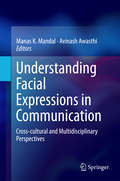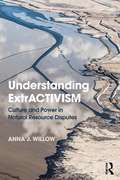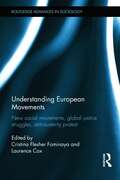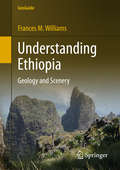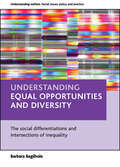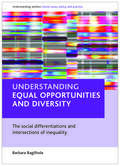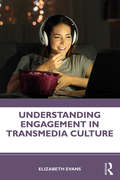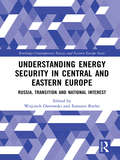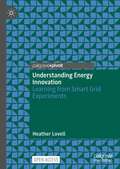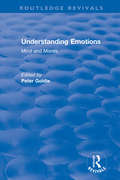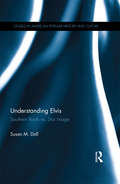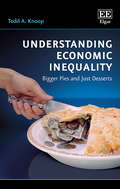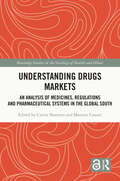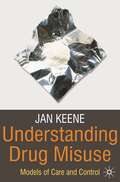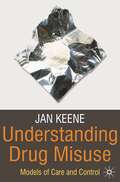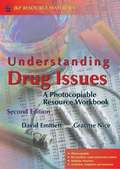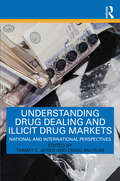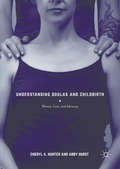- Table View
- List View
Understanding Facial Expressions in Communication: Cross-cultural and Multidisciplinary Perspectives
by Manas K. Mandal Avinash AwasthiThis important volume provides a holistic understanding of the cultural, psychological, neurological and biological elements involved in human facial expressions and of computational models in the analyses of expressions. It includes methodological and technical discussions by leading scholars across the world on the subject. Automated and manual analysis of facial expressions, involving cultural, gender, age and other variables, is a growing and important area of research with important implications for cross-cultural interaction and communication of emotion, including security and clinical studies. This volume also provides a broad framework for the understanding of facial expressions of emotion with inputs drawn from the behavioural sciences, computational sciences and neurosciences.
Understanding ExtrACTIVISM: Culture and Power in Natural Resource Disputes
by Anna J. WillowUnderstanding ExtrACTIVISM surveys how contemporary resource extractive industry works and considers the responses it inspires in local citizens and activists. Chapters cover a range of extractive industries operating around the world, including logging, hydroelectric dams, mining, and oil and natural gas extraction. Taking an activist anthropological stance, Anna Willow examines how culture and power inform recent and ongoing disputes between projects’ proponents and opponents, beneficiaries and victims. Through a series of engaging case studies, she argues that diverse contemporary natural resource conflicts are underlain by a culturally constituted ‘extractivist’ mind-set and embedded in global patterns of political inequity. Offering a synthesizing framework for making sense of complex interconnections among environmental, social, and political dimensions of natural resource disputes, Willow reflects on why extractivism exists, why it matters, and what we might be able to do about it. The book is valuable reading for students and researchers in the environmental social sciences as well as for activists and practitioners.
Understanding ExtrACTIVISM: Culture and Power in Natural Resource Disputes
by Anna J. WillowUnderstanding ExtrACTIVISM surveys how contemporary resource extractive industry works and considers the responses it inspires in local citizens and activists. Chapters cover a range of extractive industries operating around the world, including logging, hydroelectric dams, mining, and oil and natural gas extraction. Taking an activist anthropological stance, Anna Willow examines how culture and power inform recent and ongoing disputes between projects’ proponents and opponents, beneficiaries and victims. Through a series of engaging case studies, she argues that diverse contemporary natural resource conflicts are underlain by a culturally constituted ‘extractivist’ mind-set and embedded in global patterns of political inequity. Offering a synthesizing framework for making sense of complex interconnections among environmental, social, and political dimensions of natural resource disputes, Willow reflects on why extractivism exists, why it matters, and what we might be able to do about it. The book is valuable reading for students and researchers in the environmental social sciences as well as for activists and practitioners.
Understanding European Movements: New Social Movements, Global Justice Struggles, Anti-austerity Protest (Routledge Advances In Sociology Ser.)
by Cristina Flesher Fominaya Laurence CoxEuropean social movements have been central to European history, politics, society and culture, and have had a global reach and impact. Yet they have rarely been taken on their own terms in the English-language literature, considered rather as counterpoints to the US experience. This has been exacerbated by the failure of Anglophone social movement theorists to pay attention to the substantial literatures in languages such as French, German, Spanish or Italian – and by the increasing global dominance of English in the production of news and other forms of media. This book offers a comprehensive, interdisciplinary perspective on the key European social movements in the past forty years. It will be of interest for students and scholars of politics and international relations, sociology, history, European studies and social theory.
Understanding Ethiopia: Geology and Scenery (GeoGuide)
by Frances M. WilliamsUnderstanding Ethiopia is a detailed description of Ethiopia’s geological story and enables non-specialist readers to share the author’s thrill at gaining a deeper insight into the processes which produced, and continue to shape, this amazing country. Ethiopia’s spectacular landscapes, ranging from mountains over 4500m high to salt plains 150m below sea level, are a reflection of the geological processes that formed the country. Indeed, its history and the historical sites, for which it is renowned, are largely determined by geology. Readers learn why and how Ethiopia’s geology is both unique and dynamic, as here the earth’s crust is in the process of breaking apart.
Understanding equal opportunities and diversity: The social differentiations and intersections of inequality (Understanding Welfare: Social Issues, Policy and Practice series)
by Barbara BagilholeThis is a seminal time for Equal Opportunities and Diversity (EO&D) in the UK: the three existing Equality Commissions have been amalgamated into the Commission for Equality and Human Rights and a new Single Equality Act was published in 2010. The concepts of EO&D now incorporate gender, ethnicity, disability, sexual orientation, religion and belief and age inequalities. For the future, the problems of separate and relative deprivation, and conflicting experiences and interests, must be tackled, both between and within different categories of disadvantage. These different, complex and sometimes contradictory strands in legislation, policy and practice need to be analysed and understood in order to facilitate genuine social change. This book challenges the official discourse that shapes the debates on EO&D at national, regional and European level. The book will be a key text for students and researchers of EO&D in criminology, social policy, sociology, women's studies, gender studies, public administration, business studies, economics and management and industrial relations, at both undergraduate and postgraduate courses. It will also be of interest to EO&D professionals and policy makers in public and private sector organisations.
Understanding equal opportunities and diversity: The social differentiations and intersections of inequality (Understanding Welfare: Social Issues, Policy and Practice series)
by Barbara BagilholeThis is a seminal time for Equal Opportunities and Diversity (EO&D) in the UK: the three existing Equality Commissions have been amalgamated into the Commission for Equality and Human Rights and a new Single Equality Act was published in 2010. The concepts of EO&D now incorporate gender, ethnicity, disability, sexual orientation, religion and belief and age inequalities. For the future, the problems of separate and relative deprivation, and conflicting experiences and interests, must be tackled, both between and within different categories of disadvantage. These different, complex and sometimes contradictory strands in legislation, policy and practice need to be analysed and understood in order to facilitate genuine social change. This book challenges the official discourse that shapes the debates on EO&D at national, regional and European level. The book will be a key text for students and researchers of EO&D in criminology, social policy, sociology, women's studies, gender studies, public administration, business studies, economics and management and industrial relations, at both undergraduate and postgraduate courses. It will also be of interest to EO&D professionals and policy makers in public and private sector organisations.
Understanding Engagement in Transmedia Culture
by Elizabeth EvansThis book offers a new, interdisciplinary model for understanding audience engagement as a type of behaviour, a form of response and a cost to audiences that, combined, offer value to the screen industries. Audience ‘engagement’ has become the key priority of the screen industries. Understanding Engagement in Transmedia Culture explicitly asks what audiences and screen practitioners mean when they say content is ‘engaging’ and uses audience focus groups and practitioner interviews to offer a model for understanding the relationship between the screen industry, the content it produces and its audiences. In particular, the model addresses engagement within transmedia culture. As digital screen technologies proliferate, audiences move seamlessly across and between different devices, content formats and distribution platforms, blurring the boundaries between film, television and videogames. This book offers a way of understanding audience engagement that is not restricted to a single media but instead accounts for and adapts to the various ways in which screen content is experienced. Offering a unique approach by presenting practitioner and audience perspectives, it is perfect for students and scholars working in film and television studies, as well as media industries and audience studies.
Understanding Engagement in Transmedia Culture
by Elizabeth EvansThis book offers a new, interdisciplinary model for understanding audience engagement as a type of behaviour, a form of response and a cost to audiences that, combined, offer value to the screen industries. Audience ‘engagement’ has become the key priority of the screen industries. Understanding Engagement in Transmedia Culture explicitly asks what audiences and screen practitioners mean when they say content is ‘engaging’ and uses audience focus groups and practitioner interviews to offer a model for understanding the relationship between the screen industry, the content it produces and its audiences. In particular, the model addresses engagement within transmedia culture. As digital screen technologies proliferate, audiences move seamlessly across and between different devices, content formats and distribution platforms, blurring the boundaries between film, television and videogames. This book offers a way of understanding audience engagement that is not restricted to a single media but instead accounts for and adapts to the various ways in which screen content is experienced. Offering a unique approach by presenting practitioner and audience perspectives, it is perfect for students and scholars working in film and television studies, as well as media industries and audience studies.
Understanding Energy Security in Central and Eastern Europe: Russia, Transition and National Interest (Routledge Contemporary Russia and Eastern Europe Series)
by Wojciech Ostrowski Eamonn ButlerThe purpose of this book is to move beyond the approach which views energy as a purely geopolitical tool of the Russian state and assumes a 'one size fits all' approach to energy security in Central and Eastern Europe (CEE). It argues that in order to fully understand Russian involvement in the regional energy complex, the CEE-Russian energy relationship should be analysed in the context of the political and economic transitions that Russia and the CEE states underwent. The chapters on individual countries in the book demonstrate that, although Russia has and will continue to play a substantial role in the CEE energy sector, the scope of its possible influence has been overstated.
Understanding Energy Security in Central and Eastern Europe: Russia, Transition and National Interest (Routledge Contemporary Russia and Eastern Europe Series)
by Wojciech Ostrowski Eamonn ButlerThe purpose of this book is to move beyond the approach which views energy as a purely geopolitical tool of the Russian state and assumes a 'one size fits all' approach to energy security in Central and Eastern Europe (CEE). It argues that in order to fully understand Russian involvement in the regional energy complex, the CEE-Russian energy relationship should be analysed in the context of the political and economic transitions that Russia and the CEE states underwent. The chapters on individual countries in the book demonstrate that, although Russia has and will continue to play a substantial role in the CEE energy sector, the scope of its possible influence has been overstated.
Understanding Energy Innovation: Learning from Smart Grid Experiments
by Heather LovellThis open access book uses smart grids to explore and better understand energy innovation, from a social science perspective. Understanding Energy Innovation has four core themes—networks, nodes, narratives and nostalgia—and each chapter tackles a theme, using case studies from Australia and Europe. Energy innovation is currently occurring at a rapid pace, in response to a host of problems including climate change, high energy prices, and unreliable supply. Understanding Energy Innovation provides ways to think about and plan for energy sector reform and innovation, drawing on core ideas from social and innovation theory, and centred on smart grids as a case study. These academic ideas are written about in an accessible way, recognising that a diversity of people have an interest in energy innovation generally, and smart grids more specifically, and would like to find out more about ways of understanding energy innovation that integrate the social and the political.
Understanding Emotions: Mind and Morals (Routledge Revivals)
by Peter GoldieThis title was first published in 2002: At the end of the 20th century, the emotions ceased to be a neglected topic for philosophical consideration. The editor suggests that this may, in part, be due to a change in the way the subject is approached. The emotions were characteristically thought of by philosophers as states which give rise to perturbation in what might roughly be called "right-thinking". The basic idea was that practical reasoning, like theoretical reasoning, ought to be, and can be, dispassionate. This means that either the emotions interfere with "right-reasoning" in a way which is a proper object of study for the biological sciences but not for the science of the mind, or that the emotions become reducible to, and analyzable as, collections of propositional attitudes which are themselves assessable in terms of "right-reasoning". The move away from this idea is taken as an improvement in our philosophical approach to the emotions by the authors. Following this, all of the papers in the volume contribute to this philosophical approach, each approaching the subject from a different angle.
Understanding Emotions: Mind and Morals (Routledge Revivals)
by Peter GoldieThis title was first published in 2002: At the end of the 20th century, the emotions ceased to be a neglected topic for philosophical consideration. The editor suggests that this may, in part, be due to a change in the way the subject is approached. The emotions were characteristically thought of by philosophers as states which give rise to perturbation in what might roughly be called "right-thinking". The basic idea was that practical reasoning, like theoretical reasoning, ought to be, and can be, dispassionate. This means that either the emotions interfere with "right-reasoning" in a way which is a proper object of study for the biological sciences but not for the science of the mind, or that the emotions become reducible to, and analyzable as, collections of propositional attitudes which are themselves assessable in terms of "right-reasoning". The move away from this idea is taken as an improvement in our philosophical approach to the emotions by the authors. Following this, all of the papers in the volume contribute to this philosophical approach, each approaching the subject from a different angle.
Understanding Elvis: Southern Roots vs. Star Image (500 Tips)
by Susan M. DollAlthough the importance of Elvis Presley's Southern heritage has long been recognized, few have considered the complex connection between the performer's career and his Southern roots. This study investigates how that identity affected each stage of Presley's career. Elvis Presley's career can be divided into three phases, each of which is signified by a specific image. Each image is coded by a certain style of music, mode of dress, and arena of performance. The evolution from one career phase to another was instigated by a specific event and represented a deliberate calculation on the part of Presley's manager to attract a wider audience. The first stage spans the years 1956 through 1958, after the singer was introduced to a national audience and before he was drafted into the army. His image as a notorious rock 'n' roller created a national controversy and was spurred by negative depictions of Presley in the media-many attributing his controversial performing style and appearance to his Southern background. His music was a fusion of rhythm and blues and country-western; or, two types of music indigenous to the South and foreign to the mainstream entertainment industry based in New York City. The second phase of Elvis' career included his stint as a movie star, in which most aspects of his Southern identity were extracted from his leading man image to enhance his appeal to the mainstream. And, finally, the last stage of his career focused on his image as a Las Vegas performer. Despite the gaudy costumes, Elvis reconnected to his identity as a Southerner in the 1970s by returning to country music and songwriters as a source of inspiration.
Understanding Elvis: Southern Roots vs. Star Image (500 Tips)
by Susan M. DollAlthough the importance of Elvis Presley's Southern heritage has long been recognized, few have considered the complex connection between the performer's career and his Southern roots. This study investigates how that identity affected each stage of Presley's career. Elvis Presley's career can be divided into three phases, each of which is signified by a specific image. Each image is coded by a certain style of music, mode of dress, and arena of performance. The evolution from one career phase to another was instigated by a specific event and represented a deliberate calculation on the part of Presley's manager to attract a wider audience. The first stage spans the years 1956 through 1958, after the singer was introduced to a national audience and before he was drafted into the army. His image as a notorious rock 'n' roller created a national controversy and was spurred by negative depictions of Presley in the media-many attributing his controversial performing style and appearance to his Southern background. His music was a fusion of rhythm and blues and country-western; or, two types of music indigenous to the South and foreign to the mainstream entertainment industry based in New York City. The second phase of Elvis' career included his stint as a movie star, in which most aspects of his Southern identity were extracted from his leading man image to enhance his appeal to the mainstream. And, finally, the last stage of his career focused on his image as a Las Vegas performer. Despite the gaudy costumes, Elvis reconnected to his identity as a Southerner in the 1970s by returning to country music and songwriters as a source of inspiration.
Understanding Economic Inequality: Bigger Pies and Just Desserts
by Todd A. KnoopOver the last 25 years, nearly two billion people across the globe have risen out of poverty and income levels have risen worldwide. Yet in the US, the top 1% earn twice the amount of income as the poorest 50% of the population. In the midst of rising prosperity, economic dissatisfaction—driven by the persistent fear felt by many that they are “falling behind”—is higher than at any point since the 1930s. In Understanding Economic Inequality, the author brings an economist’s perspective informed by new, groundbreaking research on inequality from philosophy, sociology, psychology, and political science and presents it in a form that it is accessible to those who want to understand our world, our society, our politics, our paychecks, and our neighbors’ paychecks better. As any history of the 21st century would be incomplete without understanding “the 99% versus the 1%”, the insights provided by the author will prove valuable to any reader. This book also provides the foundation for undergraduate courses on wealth and income inequality, and an essential reading for introductory economics, labor economics, public policy, law, or sociology courses.
Understanding Drugs Markets: An Analysis of Medicines, Regulations and Pharmaceutical Systems in the Global South
by Carine BaxerresDrawing on anthropology, historical sociology and social-epidemiology, this multidisciplinary book investigates how pharmaceuticals are produced, distributed, prescribed, (and) consumed, and regulated in order to construct a comprehensive understanding of the issues that drive (medicine) pharmaceutical markets in the Global South today. Based on primary research conducted in Benin and Ghana, and additional data collected in Cambodia and the Ivory Coast, this volume uses artemisinin-based combination therapies (ACTs) against malaria as a central case study. It highlights the influence of the countries colonial and post-colonial history on their models for state regulation, production, and distribution, explores the determining role transnational actors as well as industries from the North but also and increasingly from the South play in influencing local pharmaceutical markets and looks at the behaviour of health care professionals and individuals. Stepping back, the authors then unpick the pharmaceuticalization process and the multiple regulations at stake by looking at the workings of, and linkages between, (biomedical health) pharmaceutical systems, (representatives of companies) industries, actors in private distribution, and consumer practices. Providing a thorough comparative analysis of the advantages and disadvantages of different pharmaceutical systems, it is an important contribution to the literature on pharmaceutalization and the governance of medication. It is of interest to students, researchers and policy-makers interested in medical anthropology, the sociology of health and illness, global health, healthcare management and pharmacy. The Open Access version of this book, available at http://www.taylorfrancis.com/books/9780429329517, has been made available under a Creative Commons Attribution-Non Commercial-No Derivatives 4.0 license.
Understanding Drugs Markets: An Analysis of Medicines, Regulations and Pharmaceutical Systems in the Global South
by Carine Baxerres Maurice CassierDrawing on anthropology, historical sociology and social-epidemiology, this multidisciplinary book investigates how pharmaceuticals are produced, distributed, prescribed, (and) consumed, and regulated in order to construct a comprehensive understanding of the issues that drive (medicine) pharmaceutical markets in the Global South today. Based on primary research conducted in Benin and Ghana, and additional data collected in Cambodia and the Ivory Coast, this volume uses artemisinin-based combination therapies (ACTs) against malaria as a central case study. It highlights the influence of the countries colonial and post-colonial history on their models for state regulation, production, and distribution, explores the determining role transnational actors as well as industries from the North but also and increasingly from the South play in influencing local pharmaceutical markets and looks at the behaviour of health care professionals and individuals. Stepping back, the authors then unpick the pharmaceuticalization process and the multiple regulations at stake by looking at the workings of, and linkages between, (biomedical health) pharmaceutical systems, (representatives of companies) industries, actors in private distribution, and consumer practices. Providing a thorough comparative analysis of the advantages and disadvantages of different pharmaceutical systems, it is an important contribution to the literature on pharmaceutalization and the governance of medication. It is of interest to students, researchers and policy-makers interested in medical anthropology, the sociology of health and illness, global health, healthcare management and pharmacy. The Open Access version of this book, available at http://www.taylorfrancis.com/books/9780429329517, has been made available under a Creative Commons Attribution-Non Commercial-No Derivatives 4.0 license.
Understanding Drug Misuse: Models of Care and Control
by Jan KeeneKey to understanding drug misuse is an awareness of the full range of models that seek to define, explain and treat the problem. This book covers the full breadth of medical, social and psychological approaches to drug use, while retaining focus on the one question which is seldom asked: What do drug users themselves think? Based on extensive research, Understanding Drug Misuse offers comprehensive analysis of the diversity of drug-related problems, interwoven with frank – and often challenging – user perspectives. Combining theory and research evidence with extracts from the author's own interviews with drug users, this insightful text explores:drug use, drug dependence and discussion of maintenance versus abstinencehealth risks, harm minimization and public health solutionssocial harm, social exclusion, and problems of community safety and crimepractice implications for harm minimization, treatment, after-care and relapse preventionWith practical guidance that will inform all work directly related to drug policy or practice, Understanding Drug Misuse is an essential text for all students taking modules in substance abuse and addiction studies. It also makes fascinating and fundamental reading for specialist and generic workers in the health, social care and criminal justice professions.
Understanding Drug Misuse: Models of Care and Control
by Jan KeeneKey to understanding drug misuse is an awareness of the full range of models that seek to define, explain and treat the problem. This book covers the full breadth of medical, social and psychological approaches to drug use, while retaining focus on the one question which is seldom asked: What do drug users themselves think?Based on extensive research, Understanding Drug Misuse offers comprehensive analysis of the diversity of drug-related problems, interwoven with frank – and often challenging – user perspectives. Combining theory and research evidence with extracts from the author's own interviews with drug users, this insightful text explores: - Drug use, drug dependence and discussion of maintenance versus abstinence- Health risks, harm minimization and public health solutions- Social harm, social exclusion, and problems of community safety and crime- Practice implications for harm minimization, treatment, after-care and relapse preventionWith practical guidance that will inform all work directly related to drug policy or practice, Understanding Drug Misuse is an essential text for all students taking modules in substance abuse and addiction studies. It also makes fascinating and fundamental reading for specialist and generic workers in the health, social care and criminal justice professions.
Understanding Drug Issues: A Photocopiable Resource Workbook Second Edition (PDF)
by David Emmett Graeme NiceThis fully updated edition of a successful resource succeeds in engaging and involving young people where many other methods of drugs education - including attempts to shock, inform, or promote decision-making - have failed to make a lasting impact. This is largely because they don't utilize young people's own views, intelligence and insight. The range of 30 original exercises in this resource is designed to expand and challenge participants' understanding of the issues surrounding illegal drug use, with activities that will enable them to make active and informed personal judgements about drugs. Understanding Drug Issues features informative and balanced material on all the key issues involved, including: * the facts and fiction about drugs * peer pressure * the social consequences of drug use * buying drugs * the dangers involved in using * the pros and cons of drug use * legal implications * the effects of drugs on health. The activities are ideal for use in groups and feature all the latest developments surrounding the use and abuse of drugs, as well as useful contact details for those wanting further help. The material is photocopiable and designed to be used flexibly - for example as worksheets or overhead projections. Understanding Drug Issues is an essential resource that will be valued by teachers, youth workers, probation officers, those working with offenders, and any professionals working with young people. This workbook can be used on its own, or ideally in combination with its companion volume Understanding Drugs: A Handbook for Parents, Teachers and Other Professionals, a complete reference on drugs issues (second edition forthcoming, September 2005).
Understanding Drug Dealing and Illicit Drug Markets: National and International perspectives
by Tammy C Ayres Craig AncrumThis book examines the drug dealer in contemporary society from an interdisciplinary perspective and considers the increasingly blurred demarcation between illegitimate and legitimate drug markets. It explores the motives and drivers of those involved in drug supply and dispels common and stereotypical myths and misconceptions surrounding illegal drug markets and those who operate within them. The drug dealer has become one of our foremost contemporary ‘folk devils’. Those who trade in substances prohibited by law are the subject of array of inaccurate myths and urban legends. Criminology has tended either to shoehorn drug dealers into neat typologies or portray them as ‘victims’ of an uncaring, predatory post-modern society. In reality, we know relatively little about the complex and diverse world of drug markets and our concentration inevitably falls on low-end ‘retail’ dealers who operate in the most visible sectors of the illegal economy. Bringing together an international group of experts, this book considers perspectives from around the world, including UK, USA, South America, Spain, India and Australia. This book will be of interest to students and researchers across criminology, law, sociology, criminal justice and public health, and will be essential reading for those taking courses on drugs, drug markets and substance misuse.
Understanding Drug Dealing and Illicit Drug Markets: National and International perspectives
This book examines the drug dealer in contemporary society from an interdisciplinary perspective and considers the increasingly blurred demarcation between illegitimate and legitimate drug markets. It explores the motives and drivers of those involved in drug supply and dispels common and stereotypical myths and misconceptions surrounding illegal drug markets and those who operate within them. The drug dealer has become one of our foremost contemporary ‘folk devils’. Those who trade in substances prohibited by law are the subject of array of inaccurate myths and urban legends. Criminology has tended either to shoehorn drug dealers into neat typologies or portray them as ‘victims’ of an uncaring, predatory post-modern society. In reality, we know relatively little about the complex and diverse world of drug markets and our concentration inevitably falls on low-end ‘retail’ dealers who operate in the most visible sectors of the illegal economy. Bringing together an international group of experts, this book considers perspectives from around the world, including UK, USA, South America, Spain, India and Australia. This book will be of interest to students and researchers across criminology, law, sociology, criminal justice and public health, and will be essential reading for those taking courses on drugs, drug markets and substance misuse.
Understanding Doulas and Childbirth: Women, Love, and Advocacy
by Cheryl A. Hunter Abby HurstThis book contextualizes how having a doula, or labor-support woman, present during childbirth results in lower rates of medical interventions. American women are inundated with views that childbirth is inherently risky, their bodies deficient, and therefore encouraged to accept the medicalized nature of childbirth resulting in high rates of unwarranted interventions that can pose significant risk in a normal pregnancy. Why is birthing with a doula different? The narratives in this book support the belief that doulas often question the high rates of medical interventions in childbirth, fundamentally lodging a critique about the medicalization of childbirth to the women they serve. These stories share a very different philosophy about childbirth; one where the female body is capable, resilient, and not normally requiring external medical intervention. Doulas enter into a care-provider relationship that focuses on the experience of the birth as something transformative, to be honored and centered on the woman’s body in an active role in the process. Lastly, doulas model to their clients both love and advocacy because doulas believe that modeling these behaviors will translate as women become mothers through the process of childbirth.
